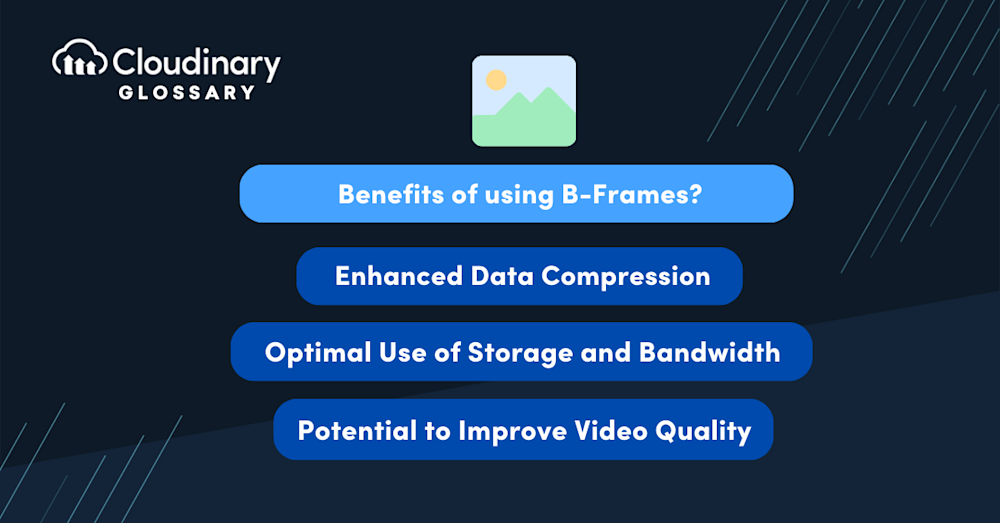Bidirectional-predictive Frames, or B-frames, are components of the video compression process that help maximize efficiency and minimize data size. They do this by referencing both preceding (past) and following (future) frames to determine their content — like referencing the pages before and after in a book to understand the current page. This ensures only the changes between frames, not the entire frame content, are encoded, enhancing data compression.
Some key attributes of B-Frames include:
- They reduce redundancy in video data by referencing both previous and future frames.
- B-frames often contain the least data among the three frame types (I, P, B).
- They contribute significantly to the efficiency of the MPEG compression process.
- Unlike I-frames and P-frames, B-frames can use both backward and forward prediction.
- Using B-frames can improve video quality but may increase encoding complexity.
How B-Frames Work
To understand how B-frames operate, it’s essential to first grasp the concept of video compression. Video compression reduces the amount of data required to represent a video sequence, making it much more manageable in terms of storage and transmission.
The process involves breaking down video frames into keyframes (I-frames) and two types of predicted frames (P-frames and B-frames), each uniquely enhancing compression efficiency. While I-frames and P-frames reduce data redundancy in a linear fashion, B-frames take compression a step further by using bidirectional prediction.
B-frames are efficient compared to I-frames and P-frames because they store only the differences between their reference frames. To do this, B-frames employ motion estimation techniques to predict the pixel values for each block in the frame.
By referencing both preceding and following frames, they can encode this information as motion vectors, borrowing content from the past and future. The result is a lower data consumption with a strong degree of compression. However, to achieve this efficiency, B-frames bring increased encoding complexity and generally require more processing power to decode.
Pros and Cons of Using B-Frames
B-frames in a video compression context come with both advantages and potential caveats. Exploring these in more depth gives us a better understanding of how B-frames perform and what challenges they might pose.
Pros
- Enhanced Data Compression. B-frames represent only the difference or changes between the two reference frames, i.e., previous and next. This allows a B-frame to retain less actual picture information, significantly reducing the amount of data that needs to be transmitted or stored.
- Optimal Use of Storage and Bandwidth. Given their ability to store less data, B-frames allow for improved use of storage and bandwidth resources. This can lead to cost savings, particularly in applications where large amounts of video data are stored or transmitted.
- Potential to Improve Video Quality. By utilizing information from both past and future frames, B-Frames can deliver a higher-quality visual result in certain situations. These frames can accurately represent complex motion or intricate details within a scene that others can’t efficiently capture.
Cons
- Increased Encoding and Decoding Complexity: B-frames increase the complexity of the encoding and decoding processes due to their bidirectional prediction. This can demand more computational resources and, in some cases, lead to increased video stream latency.
- Higher Reliance on Computational Resources: B-frames involve more complex prediction algorithms and require more robust processing capabilities. This potentially puts greater demands on the hardware, leading to increased power consumption and possibly limiting their use in low-resource environments.
- Potential Delays in Real-Time Streaming: Encoding a B-frame requires buffering future frames to draw its predictive information, which could introduce latency in a live scenario.
Final Thoughts
B-frames play a vital role in video compression, contributing to enhanced data efficiency, optimal use of storage and bandwidth, and, in some cases, improved video quality. However, they also come with their own challenges, such as increased encoding and decoding complexity, higher reliance on computational resources, and potential delays in real-time streaming.
By carefully considering the pros and cons of B-frames in specific use cases, developers and technical professionals can make informed decisions on balancing performance and resource needs when it comes to video encoding.
One way to ensure you’re making the most of B-frames and other video compression techniques is to rely on a powerful and trusted solution like Cloudinary. Cloudinary offers a comprehensive suite of video management and optimization tools tailored for developers and technical professionals, taking the guesswork out of encoding and delivering high-quality video content.
Discover the power of Cloudinary and start optimizing your video content today!
Additional Resources You May Find Useful:




